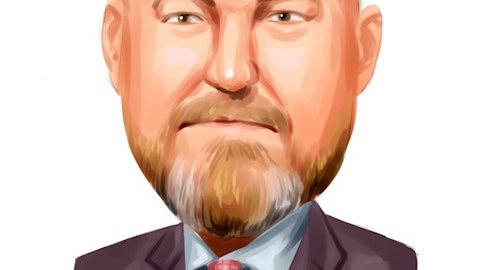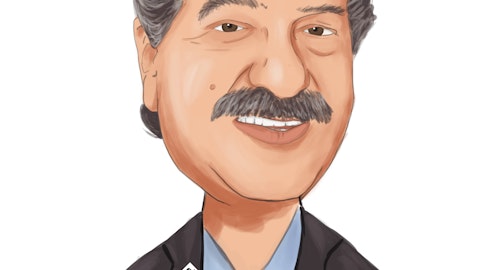John H. Watt, Jr.: Hi, Matt.
Scott Kingsley: Good morning, Matt.
Matthew Breese: I was hoping you could break out the crystal ball on deposits again. I have a follow-up. I guess, I was wondering do you think the overall mix of noninterest-bearing is at risk here? And could we go back to levels we saw pre-COVID or even prior? I mean, just given — I mean, Scott, you talked a little bit about the granularity of the book. Assuming that continues to be a structural advantage, how granular is it? And is it continually at risk from mobile banking offers that we see every day north of 3% or 4%?
Scott Kingsley: So, I would frame it this way, Matt. It’s a really good question. And by the way, our crystal ball is not that clear this morning. But at the same point, I guess what I would say is that we have seen a little bit of migration away from pure noninterest DDA into other alternatives, but it has been typically our customers with a much higher treasury acumen relative to larger businesses with full-time professionals managing their net cash flows. So, we’ve seen a little bit of that. I think in the lion’s share of the broad cross section of our business, a lot of our customers, whether they’re retail or small business, just don’t have that much excess liquidity where they think that going through the machinations of moving certain of that amounts off into alternative instruments even in the near term, is that prolific.
It’s just — for them, if you’ve got excess balances of $25,000 or $50,000, what is the net differential? We have some products in our deposit portfolio to address moving people up over time, peer-based products. So, I think those will be affected, they’ve historically been affected. But I think what you’re even seeing is that our customers still have higher than historic levels of pure checking balances, but they’re becoming a little bit better at moving those off into money market type products even on our own deposit portfolio. So, Matt, I think I’d come back around to say, I think on a peer comparison, our granularity of our retail and small business portfolio will be an advantage on the deposit side. I think like everybody, managing some of the large customer expectations and, in fairness, reminding some of those large customers how low their borrowing rates still are will be something that will continue to be a challenge for us and a task for us.
But truly, that’s about managing relationships and I think we’ll be really effective at that over time.
Matthew Breese: Got it. Okay. And then, just acknowledging that the loan to deposit ratio ticked up still well below 100%. But at 86%, any limitations there you’d put on yourself, or any ceiling you’d like us to keep in mind? And at what point does it start to impact your loan growth outlook?
John H. Watt, Jr.: So, let me start there and then Scott will pick it up. I think, historically, anybody installed NBT for a long period of time knows that we have very successfully operated this company pre-pandemic at a loan to deposit ratio in the low 90%-s, and we feel comfortable being in that territory. I don’t see us getting there very fast. But that’s not a place that we’re adverse to being at if the loan demand presents itself at the right yield. So, we still view that we got headroom here and loan demand, if strong, we’ll keep funding.
Scott Kingsley: I think that the only thing I would add to that, John, is that, Matt, I think we’ve been pretty transparent about this and John made some comments on that, we certainly don’t expect loan growth in the solar residential portfolio in 2023 to be similar to 2022’s results.
John H. Watt, Jr.: True.
Scott Kingsley: I think we’ve talked in the past about where we are today. We think we have a little bit more balance sheet capacity for that type of instrument. We’re very happy with that instrument from both a credit performance as well as effective yield performance. It’s also a borrower base that has a meaningfully higher than average FICO score. So, we like the borrowing base there. But I will say that as that business has matured and our partnership with Sungage has matured, getting to more forward flow opportunities for them, warehouse lines of credit that ultimately become securitization, that’s where that business is headed. And so, the utilization of our balance sheet won’t need to be anywhere near as proliferate going forward.
So, I think that gives us a little bit more room relative to that loan to deposit ratio. I also should remind people that not only do we think we have a couple of hundred million dollars of cash flow coming off our investment portfolio, but the portfolio was $600 million to $800 million larger than it had ever been. So, over time, that will also be a source of net liquidity for us, may or may not change our loan to deposit ratio depending on how much demand we see on the loan side, but in fairness, lots of other liquidity sources that exists within our world. And now that yields on most lending instruments are 6% or north, some mix of wholesale funding is not really a bad thing. It’s a little bit more expensive than the deposit base, but not a bad thing.
Matthew Breese: Understood. Okay. As you can imagine, this stage in the cycle and everything going on during COVID with car prices, we’re getting more questions on exposure there. Could you just remind us within that dealer finance book, how much is indirect auto versus floor plan lending? And then, kind of stratify the FICO exposures you have?
Scott Kingsley: Sure, absolutely. So, that portfolio that’s just under $1 billion is all indirect auto. We have very, very small amounts of dealer finance and/or floor plan financing, just some really older legacy relationship
John H. Watt, Jr.: Legacy less than $20 million.





